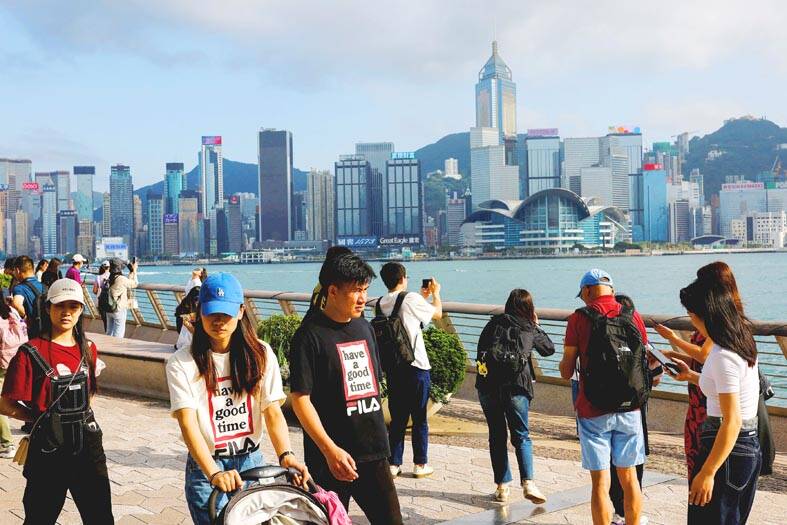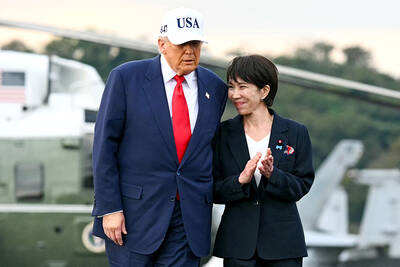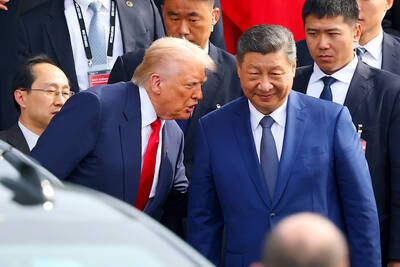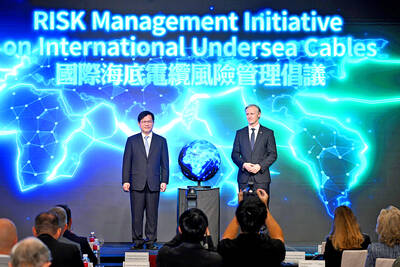Hong Kong journalists rated the territory’s press freedom lower than ever in an annual survey released yesterday, citing fears of sweeping national security laws.
Published every year since 2013 by the Hong Kong Journalists Association (HKJA) and the Hong Kong Public Opinion Research Institute, the Press Freedom Index ranks the territory’s media environment on a scale of zero to 100 — 100 being a perfect score. It is based on a poll of more than 250 working journalists and about 1,000 members of the public.
The rating this year among journalists dropped to a record low of 25, down 0.7 points from last year and 17 points from the survey’s launch.

Photo: Reuters
More than 90 percent of the surveyed journalists said that Hong Kong’s press freedom was “significantly” impacted by a new security law enacted in March, which punishes crimes such as espionage and foreign interference.
Colloquially known as Article 23, it was the second such law enacted for the financial hub, following one imposed by Beijing in 2020 after Hong Kong saw massive, and at times violent, pro-democracy protests.
Ninety-four percent of journalists also cited the prosecution of media tycoon Jimmy Lai (黎智英), founder of Hong Kong’s now-shuttered Chinese-language tabloid Apple Daily, under the first law as being “highly damaging” to press freedom.
Other concerns included the disappearance of South China Morning Post reporter Minnie Chan (陳敏莉) in Beijing.
HKJA had previously released a statement saying it was “very concerned” about Chan, an award-winning journalist, who has been unreachable since attending a security forum in Beijing last year.
For the public, the overall rating was 42.2 — largely stable after the last major drop from 45 in 2018 to 41.9 in 2019.
“This discrepancy may be explained by the relatively less heated discussion around Article 23 compared to the 2020 National Security Law,” HKJA said in a statement.
However, journalists are “more cognizant of potentially running afoul of the new crimes created by Article 23 when reporting,” it said.
The Chinese Ministry of Foreign Affairs said that Hong Kong’s security laws “target a very small number of individuals who severely endanger national security, not law-abiding media reporters.”
Since the laws’ implementation, “press freedom in Hong Kong has been better protected under a safe and stable environment in accordance with the law,” ministry spokeswoman Mao Ning (毛寧) told a regular news briefing.
The index’s publication came weeks after HKJA’s newly elected chairperson, Selina Cheng (鄭嘉如), was fired by the Wall Street Journal after she took up the new role.
The Journal’s parent company, Dow Jones, declined to comment on Cheng’s case, but said at the time that it “continues to be a fierce and vocal advocate for press freedom.”

Japanese Prime Minister Sanae Takaichi yesterday lavished US President Donald Trump with praise and vows of a “golden age” of ties on his visit to Tokyo, before inking a deal with Washington aimed at securing critical minerals. Takaichi — Japan’s first female prime minister — pulled out all the stops for Trump in her opening test on the international stage and even announced that she would nominate him for a Nobel Peace Prize, the White House said. Trump has become increasingly focused on the Nobel since his return to power in January and claims to have ended several conflicts around the world,

UKRAINE, NVIDIA: The US leader said the subject of Russia’s war had come up ‘very strongly,’ while Jenson Huang was hoping that the conversation was good Chinese President Xi Jinping (習近平) and US President Donald Trump had differing takes following their meeting in Busan, South Korea, yesterday. Xi said that the two sides should complete follow-up work as soon as possible to deliver tangible results that would provide “peace of mind” to China, the US and the rest of the world, while Trump hailed the “great success” of the talks. The two discussed trade, including a deal to reduce tariffs slapped on China for its role in the fentanyl trade, as well as cooperation in ending the war in Ukraine, among other issues, but they did not mention

REASSURANCE: The US said Taiwan’s interests would not be harmed during the talk and that it remains steadfast in its support for the nation, the foreign minister said US President Donald Trump on Friday said he would bring up Taiwan with Chinese President Xi Jinping (習近平) during a meeting on the sidelines of the APEC Summit in South Korea this week. “I will be talking about Taiwan [with Xi],” Trump told reporters before he departed for his trip to Asia, adding that he had “a lot of respect for Taiwan.” “We have a lot to talk about with President Xi, and he has a lot to talk about with us. I think we’ll have a good meeting,” Trump said. Taiwan has long been a contentious issue between the US and China.

GLOBAL PROJECT: Underseas cables ‘are the nervous system of democratic connectivity,’ which is under stress, Member of the European Parliament Rihards Kols said The government yesterday launched an initiative to promote global cooperation on improved security of undersea cables, following reported disruptions of such cables near Taiwan and around the world. The Management Initiative on International Undersea Cables aims to “bring together stakeholders, align standards, promote best practices and turn shared concerns into beneficial cooperation,” Minister of Foreign Affairs Lin Chia-lung (林佳龍) said at a seminar in Taipei. The project would be known as “RISK,” an acronym for risk mitigation, information sharing, systemic reform and knowledge building, he said at the seminar, titled “Taiwan-Europe Subsea Cable Security Cooperation Forum.” Taiwan sits at a vital junction on